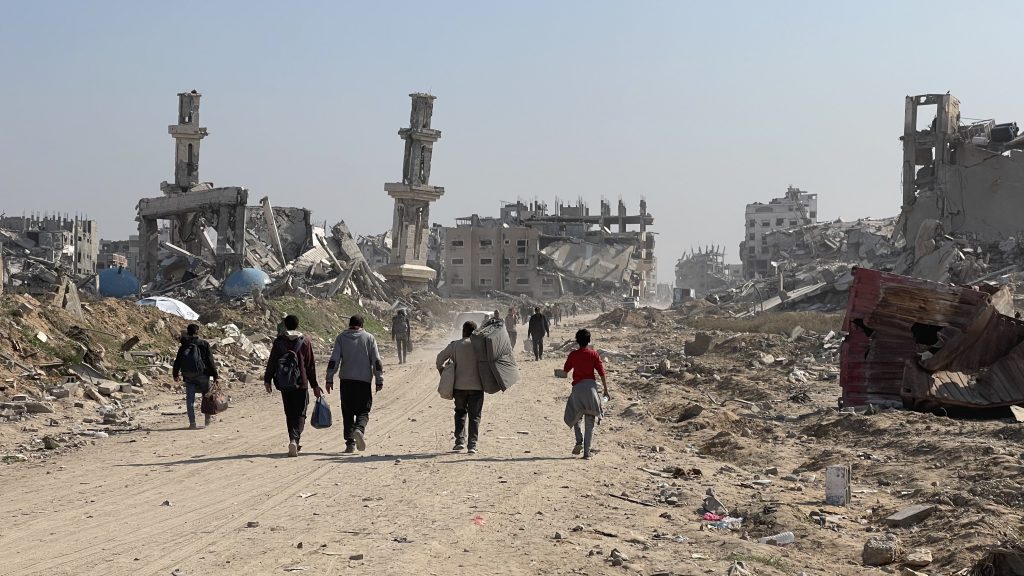This is the second of two articles by the DFLP’s Fouad Baker that have been republished in Challenge, find the first here
Amid the ongoing Israeli aggression on the Gaza Strip since October 2023, new developments have emerged in recent weeks concerning a proposed 60-day ceasefire initiative. This proposal includes phases of prisoner exchanges and humanitarian facilitation, paving the way for a potential final agreement that could extend beyond Gaza into broader regional political arrangements. The initiative, brokered by the U.S., Qatar, and Egypt, comes amidst a delicate balance between battlefield realities and political manoeuvring, as well as between a divided Palestinian negotiating body and a deeply embattled Israeli leadership.
Hamas approached the proposal put forward by the mediators as a continuation of the agreement previously reached—and then violated—by the Israeli government in March, rather than as a new accord. After extensive consultations with various resistance factions, Hamas submitted several substantive amendments focusing on international guarantees for an immediate transition to negotiations aimed at ending the war, not merely a temporary truce.
The movement also called for the inclusion of additional guarantors, the enforcement of a strict humanitarian protocol (including aid delivery, rubble removal, and the retrieval of bodies), and amendments to withdrawal maps that include a return to pre-March 2 lines.
These amendments reflect Hamas’s advanced awareness of the need to shield any agreement from Israeli manipulation and ensure that a temporary ceasefire leads to a political process that ends the war—rather than simply offering the occupation a chance to regroup.
The Israeli government, led by Benjamin Netanyahu, faces a complex dilemma: on one hand, it is under intense domestic pressure from the families of hostages and a public eager for a deal; on the other, it faces sharp divisions within its ruling coalition—especially with ministers Itamar Ben Gvir and Bezalel Smotrich publicly opposing any deal that does not result in “total victory.”
Despite such opposition, Netanyahu’s government appears more inclined this time to accept the deal, largely due to political survival motives. Besieged by corruption cases and plummeting popularity, Netanyahu sees the agreement as an opportunity to gain temporary domestic legitimacy and ease mounting U.S. and international pressure.
The United States—under President Donald Trump—has emerged as a key player in this phase, marking a departure from earlier American positions that merely supported Israel without pushing for real solutions. The Trump administration now shows a desire to broker a deal that could bring “tactical stability” to Gaza and open the door for broader regional political dialogue.
The initiative is accompanied by strategic security guarantees for Israel, including arms deals, reflecting a U.S. “carrot-and-stick” approach aimed at taming Israeli intransigence and pushing it toward an agreement that may go beyond Gaza—potentially involving new arrangements with Iran and Syria as part of a broader regional package.
Both Cairo and Doha are actively engaged in refining a formula acceptable to all sides. Egypt, with its geographic and security leverage, is working to safeguard the negotiation track, while Qatar maintains direct lines of communication with Hamas’s leadership.
While the Palestinian amendments have been appreciated by the mediators, Israel’s rejection of them threatens to derail this new round—especially in the absence of a clear vision for withdrawal phases, aid distribution, and prevention of renewed aggression.
The situation grew more complex with reports that Ezzedine Al-Haddad—the new commander of Gaza’s al-Qassam Brigades—now holds the final decision regarding the deal, following Israel’s claimed assassination of Mohammed al-Sinwar. Al-Haddad, considered a hardliner within the resistance, is known for his uncompromising stance toward Israel, suggesting a cautious negotiation posture that carefully weighs battlefield and political dynamics.
His past statements referencing inspiration from the Chechen resistance and calls for either an “honorable deal” or a “martyrdom war” indicate that Hamas will not finalize any decision unless essential conditions for political and national dignity are met—foremost among them a complete end to the war and Israeli withdrawal.
The core dilemma lies in attempting to “freeze” the war without ending it—precisely the political trap that Palestinian factions warn against. A temporary ceasefire without a clear agreement on Israeli withdrawal and lifting of the blockade could be exploited by Israel for military repositioning and the assassination of resistance leaders, as has occurred in the past. This explains the factions’ insistence on written guarantees and a clear timeline.
The current negotiation round reflects a delicate tug-of-war between a unified Palestinian will—despite internal pluralism—and international pressure led by the U.S., along with deep Israeli divisions. While the path to a final deal remains fraught with obstacles, the current initiative appears to be more than just a political manoeuvre. It is a serious test of the viability of negotiations under fire.
Ultimately, any success hinges on achieving a trinity of outcomes: ending the aggression, withdrawing the occupation, and beginning reconstruction. In this light, the unified Palestinian response—particularly its proposed amendments to the mediators’ plan—marks a mature step toward a deal that is not stripped of meaning and not built on the blood of civilians without genuine political return.
Fouad Baker is a member of the DFLP



